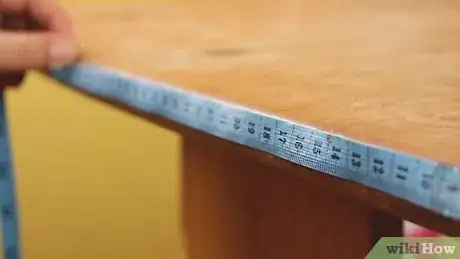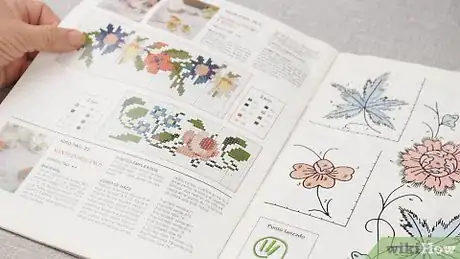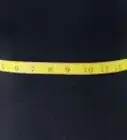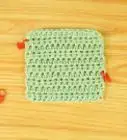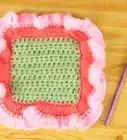This article was co-authored by wikiHow staff writer, Jessica Gibson. Jessica Gibson is a Writer and Editor who's been with wikiHow since 2014. After completing a year of art studies at the Emily Carr University in Vancouver, she graduated from Columbia College with a BA in History. Jessica also completed an MA in History from The University of Oregon in 2013.
There are 8 references cited in this article, which can be found at the bottom of the page.
The wikiHow Video Team also followed the article's instructions and verified that they work.
This article has been viewed 15,306 times.
Learn more...
Crocheting a tablecloth may seem intimidating at first, but it's actually a great project if you're developing your crocheting skills. Start by choosing a motif, such as a stitch or square, that you want to repeat across the entire tablecloth. Once you've decided the dimensions of your tablecloth, all you have to do is make motifs and join them so the cloth covers your table.
Steps
Designing Your Tablecloth
-
1Measure the dimensions of the table to determine how large to make the tablecloth. Take a measuring tape or yardstick and place it across the top of the table. If you're making a rectangular tablecloth, measure the width and length. Then, decide how much you'd like the tablecloth to hang over the sides of the table and add it to your measurement.[1]
- For example, if you have a 42 in (110 cm) table and want the tablecloth to hang over the sides by 6 inches (15 cm), you'd add 6 inches (15 cm) to each side. Your tablecloth would need to be 54 by 54 inches (140 cm × 140 cm).
-
2Choose crochet thread instead of yarn to make the tablecloth. Since crochet thread is thinner than yarn, it shows detail better. Crochet thread is made from mercerized cotton, so it won't shrink or stretch. Buy thicker crochet thread if you're new to working with it or crochet with thinner thread if you have some experience.[2]
- The amount of thread you need depends on the motif you choose, the size of your tablecloth, and the size of the thread. In general, plan on buying at least 20 to 30 skeins of yarn for a tablecloth.
- For example, pick size 3, 5, or 10 crochet thread if you're starting out since these are thicker than size 20 or 30 thread.
- Avoid using sewing or embroidery thread since it's not as thick as crochet thread.
Advertisement -
3Work with a steel crochet hook instead of a standard crochet hook. The steel hook is designed to easily grab and hold the crochet thread. Read the back of your crochet thread to see which size steel hook they recommend using. Keep in mind that a smaller number for a steel hook means the hook is actually larger.[3]
- For example, the package might recommend working with a steel size 7 (1.65 mm) or a size 8 (1.4 mm) hook.
- If you try to use a normal hook, you'll have a hard time crocheting very small loops and your tablecloth may look loose or stretched.
-
4Find a pattern for a small square motif. To make your tablecloth, you'll need to look in pattern books or online for a motif pattern. You'll make a few hundred motif pieces that you join together to form the tablecloth. Although you can use any shape or create motifs of any size, most beginners find it easier to crochet square motifs. They're also easier to join together than circular motifs.[4]
- You could work your favorite granny square as a motif for the tablecloth, for instance, or check pattern books for simple square motifs.
Variation: If you find it easier to crochet circles, feel free to make your tablecloth motif circular instead of square. For example, work your favorite circular doily pattern instead of crocheting squares.
-
5Choose a stitch pattern if you don't want to make separate square motifs. If you're pretty new to crocheting, you may feel more comfortable picking a stitch pattern that you repeat back and forth across the rows instead of creating individual motifs. This also means that you won't have to arrange and crochet the motifs together to form your tablecloth. Try any of these stitch patterns to crochet a tablecloth in any size:[5]
- Waffle or rib stitch
- Picot
- cluster stitch
- Popcorn stitch
- Star stitch
- Puff stitch
Joining Motifs to Make the Tablecloth
-
1Work as many motifs as you need for your tablecloth size. Measure the size of your crocheted motif and determine how many pieces you need for the size tablecloth you're making. Then, crochet as many pieces as you need to complete the tablecloth.[6]
- For example, if your motif measures 3 1⁄2 inches (8.9 cm) and you want to make a 70 in (180 cm) square tablecloth, you'll need 400 squares.
-
2Arrange the motifs in the order you want for the tablecloth. If you're creating a square tablecloth, make the number of motifs in the rows and columns the same. To make a rectangular tablecloth, you'll make either the rows or columns slightly larger.[7]
- For example, to make a square tablecloth, you may have 200 motifs by 200 motifs. To make the tablecloth rectangular, place 150 motifs by 250 motifs.
-
3Thread a tapestry needle with crochet thread and attach it to a motif corner. Once you've laid the motifs out, pull off about 15 inches (38 cm) of crochet thread from the skein and cut it. Tie a knot in the end and thread the other end through the eye of a tapestry needle. Then, insert the needle through the top corner of a motif square.
- Keep in mind that you'll have cut the thread and re-thread the needle repeatedly as you sew the tablecloth together.
-
4Sew the sides of the motifs to each other to form the tablecloth. Insert the needle into the opposite stitch on the motif that's next to it. Keep sewing back and forth across the sides of the motifs to join them together. It's important to work into the stitches that are directly across from each other so your squares line up. Repeat this around each side and for all of the motifs.[8]
Variation: If you want to crochet a mesh texture between the motifs, use your steel hook to chain stitches between the sides. Then, connect the chains to the opposite motif. This will make your tablecloth larger than if you sew the motifs next to each other.
-
5Crochet edging along the sides if you want a more detailed effect. Once you've joined all of the motifs, choose a stitch for the edging and work it along each side of the tablecloth. You could make scalloped, picot, or shell edging, for instance.[9]
- To give your tablecloth a simpler look, just work a row of single crochet stitches around every edge and 3 single crochet stitches into each corner. This gives it a plain edge and uniform look.
-
6Pin the edges of the tablecloth and steam it so the cloth holds its shape. Lay an old towel flat on your work surface and arrange the crocheted tablecloth flat on it. Push sewing pins through the corners and sides of the tablecloth so they go into the towel. Then, lay another old cloth over the tablecloth and press the tablecloth with your iron set to the steam setting.
- If you prefer, hang the tablecloth and hold a steamer wand about 4 inches (10 cm) away from the tablecloth. Work across the entire tablecloth to remove the wrinkles.
Things You'll Need
- Crochet thread
- Steel crochet hook
- Scissors
- Tapestry needle
- Old towel
- Iron
- Sewing pins
References
- ↑ https://www.sizes.com/home/tablecloths.htm
- ↑ https://media.rainpos.com/5968/standard_yarn_weight_system.pdf
- ↑ https://media.rainpos.com/5968/standard_yarn_weight_system.pdf
- ↑ http://grandmotherspatternbook.com/?p=2800
- ↑ https://catalog.extension.oregonstate.edu/sites/catalog/files/project/pdf/4-h962.pdf
- ↑ https://youtu.be/_CpOr3HHUEI?t=126
- ↑ http://www.knitting-crochet.com/crochet/squaday.html
- ↑ https://youtu.be/uk4pDyYTsHA?t=196
- ↑ https://www.allfreecrochet.com/Tutorials/Crochet-Borders-and-Edging-Patterns
